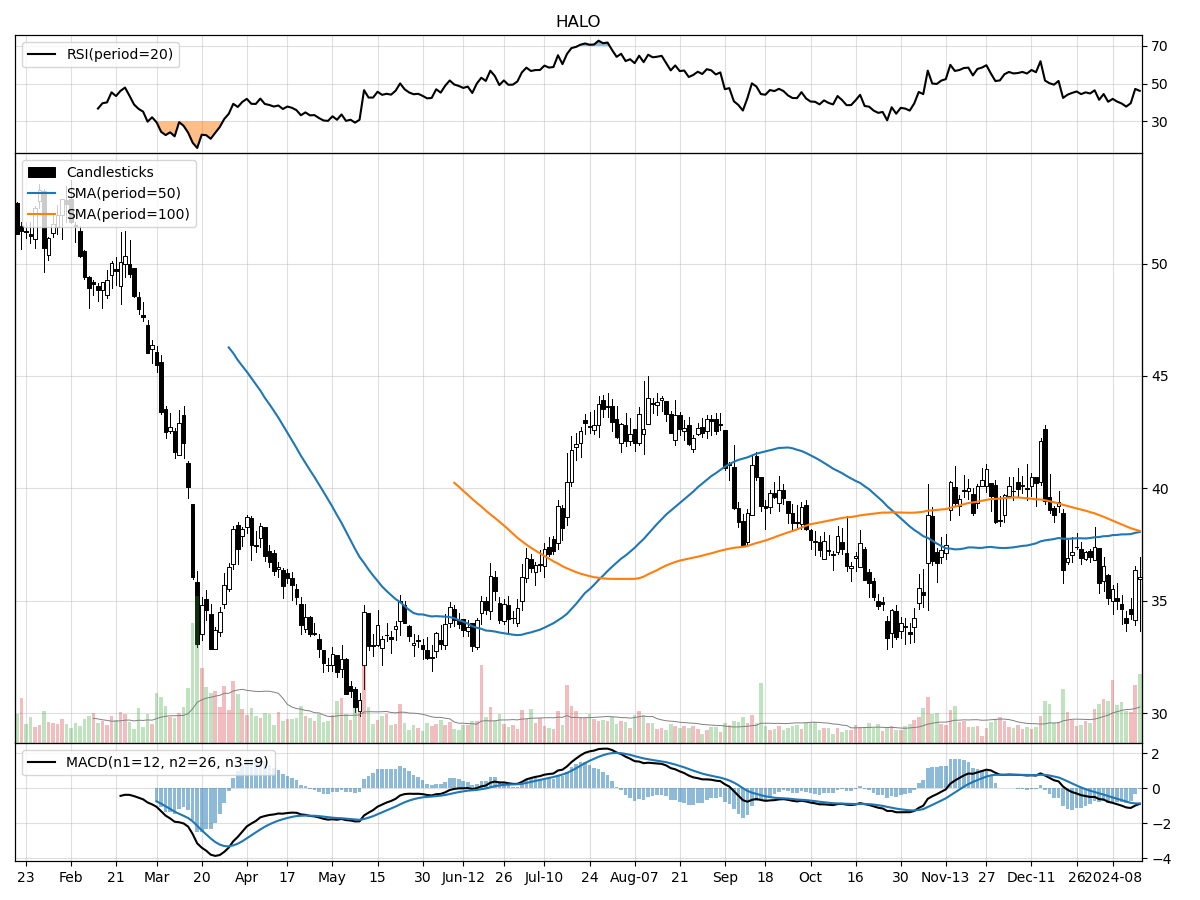Halozyme Therapeutics (HALO), Mid/Small Cap AI Study of the Week

January 18, 2024
Weekly AI Pick from the S&P 400 or S&P 600
Company Overview
Halozyme Therapeutics, Inc. is a biopharmaceutical company that focuses on developing and commercializing novel oncology therapies and transforming drug delivery with its proprietary ENHANZE technology. The company's rHuPH20 enzyme is a key component of ENHANZE, which allows for the subcutaneous delivery of injectable drugs, potentially reducing the need for intravenous administration. Halozyme earns revenue through licensing agreements, milestone payments, product sales, and royalties from partners using its technology.
The acquisition of Antares Pharma, Inc. has expanded Halozyme's portfolio to include drug-device combination products like advanced auto-injectors. Among its proprietary products are Hylenex recombinant, XYOSTED, and TLANDO. ATRS-1902, an auto-injector platform for hydrocortisone, has shown positive Phase 1 results and received FDA Fast Track designation. The company has successful partnerships with major pharmaceutical firms like Roche, Takeda, Janssen, Pfizer, AbbVie, Lilly, and Bristol Myers Squibb for the development and commercialization of various therapeutics, including treatments for cancer, multiple sclerosis, and immunodeficiencies.
Halozyme's collaborations extend to Phase 3 clinical trials with BMS for nivolumab, argenx for efgartigimod, and Horizon for a subcutaneous formulation of TEPEZZA. The company also has a global collaboration with ViiV Healthcare for HIV treatments and with Chugai for an undisclosed target. Non-pharmaceutical collaborations include Teva for an epinephrine auto-injector and Covis for Makena's auto-injector system, with Halozyme receiving royalties and sales compensation.
Despite the termination of some programs like the exenatide program with Teva and the NOCDURNA license agreement with Ferring, Halozyme continues to pursue revenue through milestones and royalties from existing agreements. The company actively protects its intellectual property through patents, with protections extending into 2039, ensuring its proprietary technology remains a valuable asset.
By the Numbers
Annual 10-K Report Summary:
- Royalty revenue increased to $360.5 million.
- Product sales surged by 83%, reaching $191.03 million.
- Collaborative agreement revenues declined by 20% to $108.61 million.
- General and administrative expenses increased, specific numbers not provided.
- Interest expenses rose to $16.9 million, up from $7.5 million in 2021.
- Reported tax expense of $46.8 million in 2022.
- Operating cash flow decreased from $299.4 million in 2021 to $240.1 million in 2022.
- Cash and marketable securities on hand: $362.8 million.
- Long-term debt: $1.54 billion.
- Near-term obligations (lease and manufacturing commitments): hundreds of millions of dollars due within the next year.
- Induced conversion expense recorded at $2.7 million.
- Anticipated cash payment for note redemption in March 2023: $13.5 million.
- Secured a $350 million Revolving Credit Facility and a $250 million Term Facility, later amended to increase the credit facility to $575 million.
Quarterly 10-Q Report Summary:
- Royalty revenues for the quarter grew to $114.4 million.
- Net product sales increased by $25.1 million.
- Operating expenses rose by $7.8 million.
- Decrease in collaboration agreement revenues by $33 million.
- Approval of Tecentriq SC in Great Britain triggered an $8 million milestone payment.
- ViiV initiated a study resulting in a $5 million milestone payment.
- FDA approval for argenx's efgartigimod in generalized myasthenia gravis.
- Financial figures may be expressed in thousands of dollars.
These figures are critical for understanding the financial health and trajectory of Halozyme Therapeutics, Inc. and should be considered in the context of the company's overall strategy, market conditions, and potential future developments.
Stock Performance and Technical Analysis

Based on the provided technical indicators, the stock currently presents a mixed outlook with bearish elements that could indicate potential risks for an investment decision. The stock price is positioned 19% above its 52-week low, which suggests some level of recent upward movement or a possible rebound from lower levels. However, the fact that it is 32% below its 52-week high indicates that the stock has experienced a significant pullback from its peak levels which might be interpreted as a negative trend or a potential discount, depending on overall market conditions and the specific circumstances of the company.
The recent decline of 7.11% in the last month, coupled with the stock's relative stability over the past three months, suggests that while the stock has not been highly volatile recently, it is currently on a downward trajectory. This may be a cause for concern for potential investors looking for short-term gains or seeking to avoid further depreciation in the near future.
The Money Flow indicators, including the distribution signal, imply that there is moderate selling pressure on the stock. This could mean that investors are gradually exiting their positions, possibly due to a lack of confidence in the stock's near-term performance or in anticipation of further price declines. The bearish Moving Average Convergence Divergence (MACD) of -0.86 reinforces the negative sentiment, as it indicates that the short-term momentum is lower than the long-term momentum, typically a sign that the stock could continue to underperform in the short run.
In conclusion, the technical analysis indicates caution for potential investors. The bearish signals from the MACD and Money Flow indicators, along with the stock's recent price decline, suggest that there may be further downside risk. An investor would need to weigh these technical indicators against the fundamental analysis of the company, including its financial health, industry position, and future growth prospects, before making an investment decision. A deeper understanding of the company's operations and the broader market context is crucial to assess whether the stock's current technical weaknesses reflect a short-term hurdle or a longer-term issue.

The ‘Bull’ Perspective
Title: Halozyme Therapeutics (HALO): A Strategic Investment Amidst Market Volatility
Upfront Summary:
- Robust Royalty Revenue Growth: Halozyme's royalty revenues have surged to $114.4 million, indicating a strong upward trajectory in the profitability of its ENHANZE technology.
- Strategic Collaborations and Approvals: The company has secured multiple global collaborations and regulatory approvals, such as the $8 million milestone from Tecentriq's approval in Great Britain.
- Innovative Technology with Wide Applicability: Halozyme's proprietary rHuPH20 enzyme and ENHANZE technology are being adopted for a variety of treatments, demonstrating their versatility and potential for expansion.
- Financial Resilience and Strategic Acquisitions: Despite market uncertainties, Halozyme maintains a solid financial position and is actively pursuing strategic acquisitions, like the Antares deal, to bolster its market presence.
- Navigating Risks with Prudence: While acknowledging the risks, Halozyme's management is adept at navigating regulatory challenges and market dynamics, positioning the company for long-term growth.
Elaboration on Key Points:
- Robust Royalty Revenue Growth:
Halozyme's financial health is underscored by a significant increase in royalty revenues, which have reached an impressive $114.4 million. This growth is fueled by the successful licensing of its ENHANZE drug delivery technology to pharmaceutical giants, leading to a steady stream of income from milestone payments and royalties. The recent positive trial results and subsequent regulatory approvals of partner products using ENHANZE are expected to further boost these royalty streams. The quantitative rise in royalty revenues not only reflects the company's current success but also lays a foundation for sustainable future earnings. - Strategic Collaborations and Approvals:
The strategic partnerships Halozyme has forged are paying off, as evidenced by the $8 million milestone payment triggered by the approval of Tecentriq SC in Great Britain. Moreover, the company's global collaborations, including the recent one with Acumen for Alzheimer's treatment, indicate a diversified and robust pipeline. The multiple approvals of Rituxan Hycela and the positive trial outcomes for Tecentriq, both utilizing ENHANZE technology, underscore the company's ability to leverage its platform for a range of treatments. These collaborations not only expand Halozyme's reach but also mitigate risk by distributing it across various partnerships and therapeutic areas. - Innovative Technology with Wide Applicability:
Halozyme's rHuPH20 enzyme is the cornerstone of its ENHANZE technology, which has been licensed to several partners for use in a wide array of treatments, from oncology to immunodeficiency. The technology's broad applicability is a testament to its innovation and potential for market penetration. With the recent approvals and ongoing trials, the technology is set to become even more entrenched in the biopharmaceutical landscape, providing a platform for long-term growth and diversification of revenue sources. - Financial Resilience and Strategic Acquisitions:
Despite facing a challenging economic environment marked by inflation concerns and potential interest rate hikes, Halozyme has demonstrated financial resilience. The company's strategic acquisitions, such as the purchase of Antares Pharma, are calculated moves to enhance its product offerings and market reach. While acquisitions come with integration risks, they also present opportunities for revenue synergy and market expansion. Halozyme's ability to execute these strategic moves without compromising its financial stability is a strong indicator of its fiscal prudence and forward-thinking management. - Navigating Risks with Prudence:
Acknowledging the risks inherent in the biopharmaceutical industry, including regulatory hurdles and dependence on partnership agreements, Halozyme's management has shown prudence in navigating these challenges. The company's proactive approach to risk management is evident in its strategic shifts and investment in technology that has broad applications. While the reliance on proprietary technology and the need for regulatory approvals introduce elements of uncertainty, Halozyme's track record of overcoming such obstacles suggests a robust risk mitigation strategy that can safeguard and potentially enhance investor value in the long term.
Conclusion:
Investing in Halozyme Therapeutics presents a compelling case for those seeking a company with a strong growth trajectory, strategic partnerships, and innovative technology in the biopharmaceutical space. Despite the broader market's susceptibility to inflation and Fed policy changes, Halozyme's robust royalty revenue streams and proactive management of risks position it as an attractive investment opportunity. With its eyes set on strategic acquisitions and navigating the regulatory landscape, HALO is poised for continued success, making it a worthy consideration for investors looking to capitalize on the dynamic healthcare sector.

The ‘Bear’ Perspective
Title: A Cautious Perspective on Halozyme Therapeutics, Inc. (HALO) Amidst a Volatile Market
Upfront Summary:
- Regulatory Uncertainty: Delays and failures in securing regulatory approvals can severely impact Halozyme's revenue stream and future growth prospects.
- Market and Economic Conditions: Current inflation trends and Federal Reserve actions are likely to affect investor confidence and the biopharmaceutical sector's stability.
- Operational Risks: Dependence on third-party manufacturers and collaborative agreements adds significant operational risks to HALO's business model.
- Strategic Shifts and Acquisition Risks: Strategic changes and the recent acquisition of Antares present integration risks and require significant capital, which may not yield the expected commercial success.
- Financial Constraints: Substantial convertible debt and financial covenants could limit HALO's operational flexibility and ability to secure additional funding.
Elaboration on Each Point:
- Regulatory Uncertainty:
Halozyme's business model hinges on the successful approval of its drug delivery platform and proprietary products by regulatory bodies such as the FDA and EMA. Any setback in this process can lead to substantial financial losses. For example, a delay in the U.S. launch of a key product like Roche's Tecentriq until 2024, due to updates in CMC processes, can significantly affect expected royalty revenues. The regulatory landscape is fraught with unpredictability, and with Halozyme's pipeline depending on these approvals, the risk is high. Even with a positive recommendation from the CHMP for argenx's efgartigimod, there's no guarantee of a smooth regulatory path ahead. - Market and Economic Conditions:
With inflation being a persistent concern and the Federal Reserve's interest rate hikes to combat it, the biopharmaceutical sector is not immune to the resulting market volatility. The economic cycle of 2023 has already seen "inflation" and "the Fed" dominate financial-market commentary, and these factors directly impact investor sentiment. For instance, the S&P 500's historical performance in entering bear markets post-highs, as well as shifts in the forward 12-month earnings estimates, can create a cautious atmosphere that may lead investors to shy away from perceived riskier investments like biotech stocks, including HALO. - Operational Risks:
HALO's reliance on third-party manufacturers for its enzyme rHuPH20 and other product components introduces a layer of operational risk. Disruptions in supply chains or manufacturing issues, as seen in various industries due to recent geopolitical tensions and public health crises, can lead to delays in product availability. Moreover, the termination or alteration of collaborative agreements, which are a significant revenue source for Halozyme, could force the company to re-evaluate its operational strategies, potentially affecting its bottom line. - Strategic Shifts and Acquisition Risks:
Strategic shifts, such as HALO's focus on its ENHANZE technology and the suspension of other programs, present risks associated with pivoting resources and expertise. The acquisition of Antares adds another layer of complexity, as integrating new technologies and teams requires substantial investment and management bandwidth. There's no guarantee these strategies will pay off, and the company's future success depends on these moves yielding profitable results. The Antares acquisition, in particular, has to demonstrate its value to justify the capital allocation and to avoid dragging down HALO's financial performance. - Financial Constraints:
HALO's financial health is a concern given its substantial convertible debt. This debt could limit the company's financial flexibility and hamper its ability to respond to market or industry changes. The covenants in the 2022 Credit Agreement place restrictions on Halozyme's operational activities, including incurring additional debt and making investments. Moreover, the servicing of existing debt is contingent on the company's cash flow, which could be compromised if product launches are delayed or fail to achieve market acceptance. Insufficient cash flow could lead to defaults or the need for accelerated repayments, further constraining the company's financial options.
In conclusion, while Halozyme Therapeutics, Inc. has demonstrated some promising developments and partnerships, the company faces a multitude of risks that cannot be overlooked. Regulatory uncertainties, the impact of broader market and economic conditions, operational risks stemming from third-party dependencies and collaborative agreements, strategic and acquisition-related risks, and financial constraints all present challenges that warrant a cautious approach to investing in HALO at this juncture. Investors should weigh these factors carefully against the potential rewards before making any decisions regarding Halozyme's stock.




Comments ()